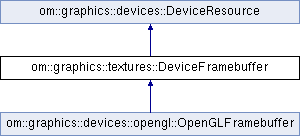 |
Om
1.0.0
A universal framework for multimedia simulation
|
 |
Om
1.0.0
A universal framework for multimedia simulation
|
A class that enables render-to-texture by specifying textures and their attachment points. More...
#include <omGraphicsDeviceFramebuffer.h>

Public Member Functions | |
| virtual Bool | getTarget (const FramebufferAttachment &attachment, Shared< DeviceTexture > &target, TextureFace &face) const =0 |
| Get the texture and texture face that is attached at the specified framebuffer attachment point. More... | |
| virtual Bool | setTarget (const FramebufferAttachment &attachment, const Shared< DeviceTexture > &newTarget, TextureFace face=TextureFace::FRONT)=0 |
| Set the target texture for the specified framebuffer attachment point. More... | |
| virtual void | clearTargets ()=0 |
| Remove all attached target textures from this framebuffer. More... | |
| Size | getSize (Index dimension) const |
| Return the minimum size of the framebuffer in pixels along the specified dimension index. More... | |
| virtual Size | getMinimumSize (Index dimension) const =0 |
| Return the minimum size of the framebuffer in pixels along the specified dimension index. More... | |
| virtual Size | getMaximumSize (Index dimension) const =0 |
| Return the maximum size of the framebuffer in pixels along the specified dimension index. More... | |
 Public Member Functions inherited from om::graphics::devices::DeviceResource Public Member Functions inherited from om::graphics::devices::DeviceResource | |
| virtual | ~DeviceResource () |
| Destroy a device object, releasing all internal state. More... | |
| GraphicsContext * | getContext () const |
| Return a pointer to the graphics context associated with this DeviceResource. More... | |
| virtual Bool | isValid () const =0 |
| Return whether or not the state of this device resource is valid and able to be used for rendering. More... | |
Protected Member Functions | |
| DeviceFramebuffer (devices::GraphicsContext *context) | |
| Create an empty framebuffer for the given context with no attached textures. More... | |
 Protected Member Functions inherited from om::graphics::devices::DeviceResource Protected Member Functions inherited from om::graphics::devices::DeviceResource | |
| DeviceResource (GraphicsContext *newContext) | |
| Create a new device object that is associated with the specified graphics context. More... | |
A class that enables render-to-texture by specifying textures and their attachment points.
A Framebuffer object contains a set of associations between rendering framebuffer attachment points and textures which are to be used for render-to-texture. This framebuffer object can then be used as a render target, where the output of rendering will be sent to the texture targets specified here rather than the main screen.
|
inlineprotected |
Create an empty framebuffer for the given context with no attached textures.
|
pure virtual |
Get the texture and texture face that is attached at the specified framebuffer attachment point.
If there is no attachment for that attachment point, the method has no effect and returns FALSE. Otherwise, the target texture and face are written to the output parameters and TRUE is returned.
Implemented in om::graphics::devices::opengl::OpenGLFramebuffer.
|
pure virtual |
Set the target texture for the specified framebuffer attachment point.
If the specified Texture is valid and supports the specified texture face, and if the specified attachment point is supported and valid, the texture is used as the target for the specified attachment point and TRUE is returned indicating success. Otherwise, FALSE is returned indicating failure, leaving the framebuffer unchanged.
Implemented in om::graphics::devices::opengl::OpenGLFramebuffer.
|
pure virtual |
Remove all attached target textures from this framebuffer.
Implemented in om::graphics::devices::opengl::OpenGLFramebuffer.
Return the minimum size of the framebuffer in pixels along the specified dimension index.
This method finds the smallest size of the attached textures along the given dimension. Indices start from 0 and count to d-1 for a framebuffer with d dimensions. Since framebuffers are almost always 1D or 2D, dimension indices greater than 1 will result in a size of 1 being returned, since even a 1x1 framebuffer has a 3D depth of 1 pixel.
If there are no attached textures, 0 is returned.
|
pure virtual |
Return the minimum size of the framebuffer in pixels along the specified dimension index.
This method finds the smallest size of the attached textures along the given dimension. Indices start from 0 and count to d-1 for a framebuffer with d dimensions. Since framebuffers are almost always 1D or 2D, dimension indices greater than 1 will result in a size of 1 being returned, since even a 1x1 framebuffer has a 3D depth of 1 pixel.
If there are no attached textures, 0 is returned.
Implemented in om::graphics::devices::opengl::OpenGLFramebuffer.
|
pure virtual |
Return the maximum size of the framebuffer in pixels along the specified dimension index.
This method finds the largest size of the attached textures along the given dimension. Indices start from 0 and count to d-1 for a framebuffer with d dimensions. Since framebuffers are almost always 1D or 2D, dimension indices greater than 1 will result in a size of 1 being returned, since even a 1x1 framebuffer has a 3D depth of 1 pixel.
If there are no attached textures, 0 is returned.
Implemented in om::graphics::devices::opengl::OpenGLFramebuffer.
 1.8.11
1.8.11